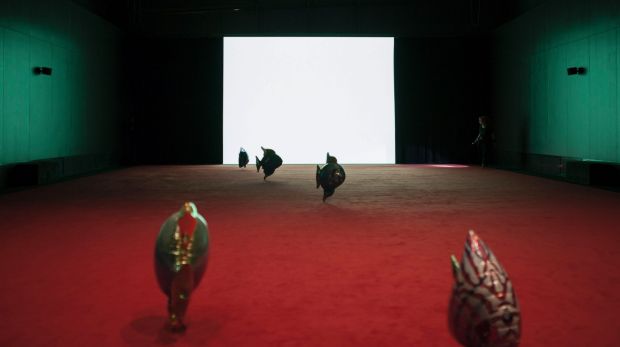By Carrie Lu
Image courtesy of The Age
It is difficult to define the work of Philippe Parreno. He deals with film, sound, installation and performance, weaving seamlessly between them by engaging the whole exhibition space as his medium.
Finding myself with some free time in the city, I decide to see his exhibition at ACMI. Descending into the lower ground gallery, each turn of the staircase takes me further into the darkness. My eyes struggle to adjust, with other senses quickly sharpening to compensate.
The stairs take me into the first part of the exhibition, an installation featuring fluorescent wall lights, casting an artificial moonlight onto a school of fish balloons sitting on the floor. One of the gallery attendants tells me that visitors are welcome to interact with the balloons, so I toss one up. It’s a lot lighter and rises much quicker than I expected. Inevitably, it swings around its peak, and gently floats back down.
But the fish balloons are not the stars of the show. At the end of the gallery space is a screen that fills the final wall of the exhibition. Walking towards it, the glow of the installation fades away, and again my senses are faced with navigating through the dark. The ground changes from a thin carpet to something padded and soft.
The gallery technician announces the next work. His announcement is highly reverbed, and contends with the atmospheric rumbling throughout the exhibition. The consistent clunk of the escalator continues upstairs.
This next work is called Marilyn.
The film opens with a warmly-lit interior of a well-furnished hotel suite. The camera focuses, and defocuses, on certain items. The stack of magazines on the walnut coffee table. The desk lamp. The nib of a fountain pen moving across paper.
The warm light disappears and heavy rain sets in. A tone of urgency emerges in the narration. The fountain pen begins to retrace itself – whole paragraphs replicated in the same cursive.
Panning out slowly, we see that the pen is attached to a robotic arm, mindlessly tracing the florid cursive. Panning out further, the walls, ceiling, and floor end, revealing the room is contained within a set. Out further are the studio lights and a rain machine. The film’s slow build-up of strangeness is explained by something very familiar, yet it reveals everything that came before as a complete artifice.
Video art demands your time. As well as this, Philippe Parreno’s immersive exhibitions demand your presence. Watching three films at Thenabouts can take up to an entire hour, but I think anyone would appreciate being able to lose track of time and place, and entering Parreno’s surreal and immersive landscape.
4/5 stars

